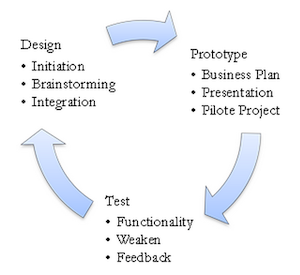The term innovation derives from the Latin verb innovare (to renew). In the economic context it stands for new ideas and inventions in terms of new products, services or means of productions put out on the market. Innovative business models are the engine for economic growth and have positive effects on growth and employment rates. [1] Innovative start-ups grow faster than imitative start-ups. The latter only exist to stimulate competition and thus only ensure that the markets do not crust. [2]
Solving problems in new ways
Innovation is all about originality. A concept is perceived as being original if it solves a problem in a surprising new way – and close to usage habits of people. If a problem solution is too far from people’s habits, it’s more difficult to penetrate the market with it. [3] Business model innovation should be developed systematically with a focus on the four aspects of resources, supply, customer and finance. [4] In this context it comes to a new combination of things and forces in the sense of a creative destruction as Joseph A. Schumpeter understood it. In his view, only the entrepreneur is innovative [5], not the imitative businessman. Innovations must break the barriers set by already existing business models. To achieve this, it helps to work with a multifaceted and selected team that is able to develop a variety of innovative ideas. [6] This is also important for companies outside the start-up stage, because nowadays their idea structures are fed from the sum and quality of systematically developed ideas. [7]
Systematically developed innovation
A possible basis for the systematic development of an innovation process is circular and consists of the following three phases [8]:

Figure: Representation of the design/prototype/test cycle Illustration of the iterative implementation process of a business model innovation. [9]
The design cycle is run iteratively to refine the granularity of the new business model. This approach offers several advantages over other methods. For instance, knowledge develops faster within the team and it’s easier to take hurdles. An innovative business model can be developed more quickly in this way.
Design
The cycle starts with design. The initiation takes place in the sense of an analysis of the surrounding actors and a consideration of other factors. The initiation goes hand in hand with finding ideas and integrating the business model. The process is iterative. At the end of the design development one or two innovative business models should be identified.
Prototype
The design materializes (or becomes more sophisticated) with a prototype. The prototype doesn’t have to be a working product, it can take various forms instead: a detailed full presentation or a business plan, among others.
Testing
Testing identifies and improves the weaknesses of a prototype. [10] During testing the prototype helps significantly to simplify abstract concepts to make them easy to understand and to measure. It also helps to balance fresh ideas. [11]
Forget causal logic
In this type of business model innovation, the founding team should not follow a causal logic. The goal flexible and not obvious but has to be negotiated with (and agreed on by) all actors involved in the process. It’s important to see that the world is not rigid, but can be changed by our actions. This means that you can make an impact and continue doing it until you like the world around you. This also means that you can create opportunities and don’t have to wait for them to come. [12] As an entrepreneur, one should be aware that not only the straight path leads to success. As an entrepreneur you rather follow a roundabout way, constantly adapting to changing situations and conditions. [13]
Success comes unexpectedly
Peter F. Drucker recognized that a start-up will be frequently successful in other markets by offering other products and services, as it was originally planned at the beginning of business activity. The products and services offered are often demanded unexpectedly from a large number of customers who had not been taken into account by the start-up before and who use the products for purposes the entrepreneur did not imagine in the beginning. It is necessary that a successful start-up as well as established companies are organized in a certain way that makes it possible to react immediately to changes in the business environment to take advantage of the unexpected and previously unrecognized.[14]
References
[1] cf. Cooley 2012, p. 42–43
[2] cf. Franke/Lüthje 2004, p. 38
[3] cf. Range 2014, p. 67
[4] cf. Osterwalder/Pigneur 2011, p. 142
[5] cf. Schäfer 2008, p. 60
[6] cf. Osterwalder/Pigneur 2011, p. 147
[7] cf. Faltin 2013, p. 98
[8] cf. Gassmann/Frankenberger/Csik 2013, p. 51
[9] based on Gassmann/Frankenberger/Csik 2013, p. 51–52
[10] cf. Gassmann/Frankenberger/Csik 2013, pp. 16, 51–52
[11] cf. Osterwalder/Pigneur 2011, p. 166
[12] cf. Faschingbauer 2013, pp. 32–33
[13] cf. Bensmann 2012, pp. 148, 154
[14] cf. Drucker 2006, p. 189
Bensmann, Burkhard (2012): Selbstführung. Wie sich kreative Entrepreneure erfolgreich organisieren, Norderstedt.
Cooley, Josh (2012): The money men (and women), in: Northern Colorado Business Report, Vol. 18 (5), pp 42–43.
Drucker, Peter F. (2006): Innovation And Entrepreneurship. Practice and Principles, Neuauflage: 9.5.2006, New York (HarperCollins Publishers).
Faltin, Günter (2013): Kopf schlägt Kapital. Die ganz andere Art, ein Unternehmen zu gründen. Von der Lust, ein Entrepreneur zu sein, 4. Auflage, München.
Faschingbauer, Michael (2013): Effectuation. Wie erfolgreiche Unternehmer denken, entscheiden und handeln, 2. Auflage, Stuttgart.
Franke, Nikolaus/Lüthje, Christian (2004): Entrepreneurship und Innovation, in: Achleitner, Ann-Kristin et al. (Hg.): Jahrbuch Entrepreneurship 2003/2004, Berlin, pp 33–46.
Gassmann, Oliver/Frankenberger, Karolin/Csik, Michaela (2013): Geschäftsmodelle entwickeln. 55 innovative Konzepte mit dem St. Galler Business Model Navigator, München.
Osterwalder, Alexander/Pigneur, Yves (2011): Business Model Generation. Ein Handbuch für Visionäre, Spielveränderer und Herausforderer, Frankfurt am Main.
Range, Thomas (2014): Ideen haben viele Freunde – aber oft keinen Markt. Warum erklärt der Technikhistoriker Reinhold Bauer, in: brand eins. Wirtschaftsmagazin, 16. Jg. (01), pp 66–70.
Schäfer, Annette (2008): Die Kraft der schöpferischen Zerstörung. Joseph A. Schumpeter. Die Biografie, Franktfurt am Main.
[picture credits: © kid_a / fotolia.com]